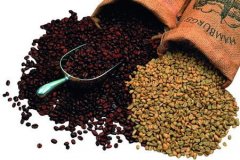Caffeic acid can effectively inhibit colitis.
Recently, researchers have found that the increased expression of a cellular respiratory enzyme (CYP4B1) is an important indicator that caffeic acid can inhibit colitis in mice. Caffeic acid is an anti-inflammatory antioxidant commonly found in food.
The findings are published in the June 2009 issue of Experimental Biology and Medicine. CYP4B1 is a cellular respiratory enzyme that has been reported in other models to be associated with the regression of allergic inflammation. Tissue damage in colitis has been pathologically observed that caffeic acid treatment can inhibit colitis and is associated with returning CYP4B1 to normal expression. Compared with rutin, a bioflavonoid, and an African potato extract (hypoxoside), all three substances have anti-inflammatory effects, inhibit the production of bone marrow peroxidase, IL-17, and iNOS, and increase the amount of IL-4, which are all related to inflammation, but only caffeic acid can protect colitis induced by glucan sulfate. This novel mechanism is related to CYP4B1, and research is under way. The team fed 8-week-old mice a diet containing the above ingredients and then given low doses of glucan sulfate to induce colitis. The study of caffeic acid allows us to further study the role and mechanism of medicinal plants or plant foods in inhibiting colitis, or in colon cancer, because colitis also increases the risk of this cancer.
In summary, a return to normal performance of CYP4B1, a drug metabolite, is associated with inhibition of inflammation-induced injury. It can be used as an indicator of the effective effect of caffeic acid, which is commonly found in plant foods in the human diet. It can inhibit small intestinal tissue damage in the way mice stimulate colitis. The research of Hendrich and colleagues can help us design more effective treatments to prevent or reduce colitis in the future.
Important Notice :
前街咖啡 FrontStreet Coffee has moved to new addredd:
FrontStreet Coffee Address: 315,Donghua East Road,GuangZhou
Tel:020 38364473
- Prev

What kind of coffee do you drink?
The choice of coffee is like an interesting game of hide-and-seek. Each caffeine variety has a different origin and has its own strong personality, but if you don't have the patience to taste it one by one, the following rules may allow you to find the right kind of coffee according to the map of your mood. Taste: people who have a lust for taste stimulation can try deep-fried coffee from Indonesia or Africa.
- Next

Coffee application: coffee hair dyeing method
Coffee itself has a strong pigment, which can be called a bad deed. For example, it is difficult to wash coffee if you dye it on clothes accidentally. This method is not easy to color all black hair, but it is suitable for yellowish brown hair. Discoloration effect brown hair dye step {1} prepare the usual amount of coffee powder for 5 people and pour it down with boiling hot water. {2} apply coffee juice to your hair
Related
- Beginners will see the "Coffee pull flower" guide!
- What is the difference between ice blog purified milk and ordinary milk coffee?
- Why is the Philippines the largest producer of crops in Liberia?
- For coffee extraction, should the fine powder be retained?
- How does extracted espresso fill pressed powder? How much strength does it take to press the powder?
- How to make jasmine cold extract coffee? Is the jasmine + latte good?
- Will this little toy really make the coffee taste better? How does Lily Drip affect coffee extraction?
- Will the action of slapping the filter cup also affect coffee extraction?
- What's the difference between powder-to-water ratio and powder-to-liquid ratio?
- What is the Ethiopian local species? What does it have to do with Heirloom native species?

